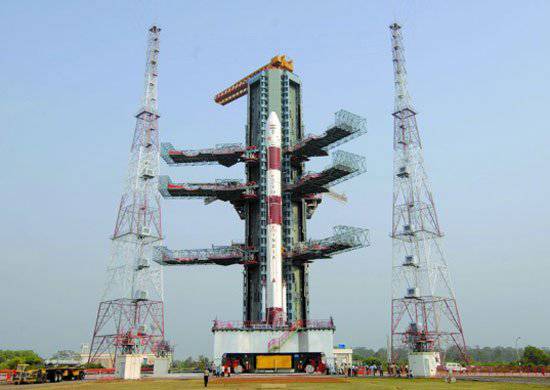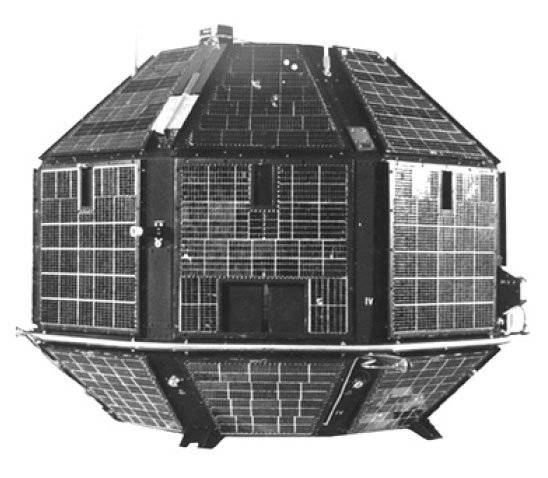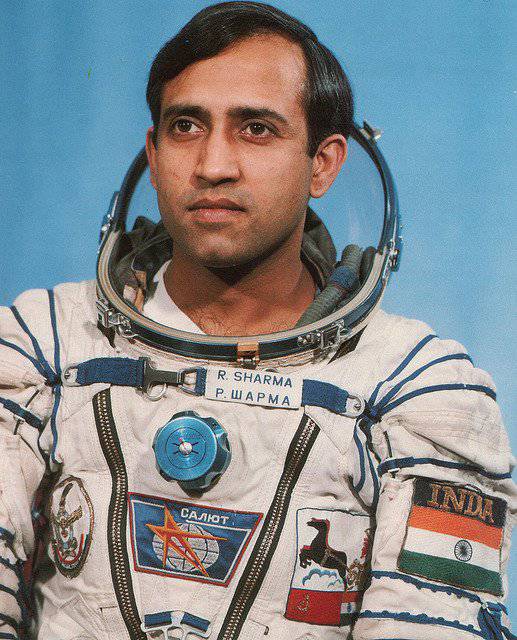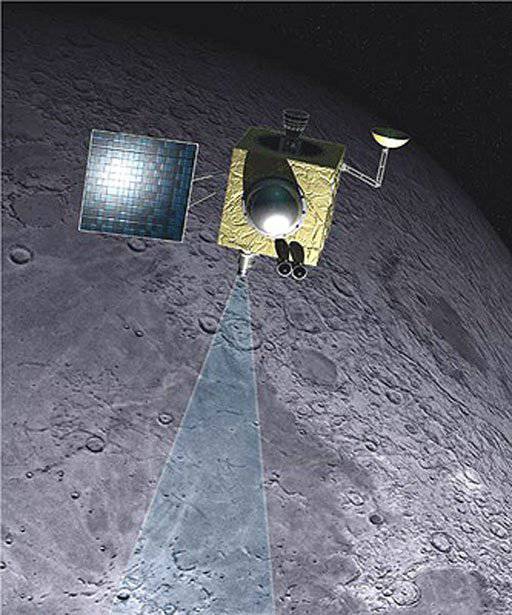India rushes into space

The space confrontation, which entered the active phase with the launch of the first artificial Earth satellite by the Soviet Union, continues to manifest itself. Moreover, if a couple of decades ago it was possible to talk about claims for leading roles in the near-Earth space of only two countries (Russia and the USA), then today and other global world players are trying to become one of the space powers. One of these states is India.
The Indian Space Research Organization (ISRO), which is a kind of Indian analogue of the American NASA, has in recent years been trying to impress the world community, and above all the countries of the countries that have been working on space exploration for some time, with their programs. The ISRO organization itself was founded in the distant 1969 year, but for almost six years it did not have time to notice anything remarkable, until it began to work closely with Soviet space experts. The result of this collaboration was the launch in 1975 of the first Indian artificial earth satellite, Ariabhata, from Kapustin Yar. Naturally, without the scientific and technical assistance of Soviet design engineers in the creation of this spacecraft has not done.

The Indian side used the satellite to study the ionosphere, solar impulses, and also to study galactic impulses. As far as India itself, which with all respect could not be called technologically and economically developed in 70, the work of Aryabhata was important - a question, as they say, rhetorical. But the very fact of the first breakthrough into space was important.
On 80-s, namely on April 1984, the flight of the first Indian cosmonaut Rakesh Sharma, who participated in the Intercosmos program organized by Moscow, took place. After the flight, the first Indian cosmonaut was awarded the highest awards in India and the USSR, becoming, in particular, the Hero of the Soviet Union and the Knight of the Order of Lenin.

It was Rakesh Sharma who, according to New Delhi, became the main ideological inspirer of India’s manned flight program, expressing the need for independent development at the 2006 conference. This event is no less epochal for India than the flight into space of its first space pilot, and is considered the beginning of the ISRO work on new ambitious projects.
With a fairly limited by current standards financing (about one billion dollars a year), the Indian space agency in terms of space exploration based on its own programs in recent years has been able to achieve tangible success. Already a couple of years after the designated conference with the participation of Rakesh Sharma, India surprised the world by launching its first stories space probe "Chandrayaan" intended for the study of the moon. It is noteworthy that the lunar satellite was sent from the Indian cosmodrome Shriharikot using the same Indian rocket PSL V-XL. At the same time, the Indian project was not only the first independent, but also brought India a tangible profit from the fact that the probe on board was carrying foreign research apparatuses belonging to the European and American Space Agency.

It is noteworthy that the Chandrayaan was not just the first Indian lunar probe, but also an apparatus that almost made the most real revolution in the minds of many theorists in the field of space research. This revolution was that the Indian probe could dispel the stereotype created by a certain circle of people over decades that the human foot had never stepped on the lunar surface. The Americans, who seemed to have exhausted all their ability to prove to skeptics that their astronauts were on the moon, began to literally pray to Chandraya because he transmitted to the Earth a number of remarkable photos of the Apollo 15 landing site, as well as traces. Moonmobile ", on which the American astronauts rode on a natural satellite of the Earth.
By the way, such photos were sent to Earth by American spacecraft, but skeptics called them just another fake, as the American device, in their opinion, cannot be objective at all ... And then suddenly a photo from an Indian, seemingly objective, Chandrayana ... But conspiracy theorists obstructed these shots, saying that they had too little permission to be judged. Indian scientists themselves, in particular Prakash Shauhan, who is the main investigator of the Chandrayan mission, spoke about a small resolution.
However, Indian specialists were less concerned about the struggle of conspiracy theories with NASA. For them it was more important that for the first time the Indian product of engineering and technical thought led to such impressive results as the flight of the apparatus to the Moon. However, the success of the Chandrayaan project could not be developed, as the connection with the device was unexpectedly interrupted. During the year of his work, the lunar probe managed to transfer to Earth more than 70 thousands of images of the lunar surface.
After the loss of ISRO communication with its lunar probe, strange rumors began to appear in the press of various countries that Russia was to blame for everything. Moreover, our country did it, they say, intentionally, in order to penetrate into the Indian program for the exploration of the moon. Indian experts left this exaggerated theory without comment, as the dispute here might have seemed like an argument with the skeptics of the man’s flight to the moon ...
Whatever it was, but Russia really showed a desire to participate in the preparation for the flight of the new Indian probe to the Moon - the project “Chanlrayan-2”. The launch of the probe is scheduled for 2013 year, and the probe itself, thanks to the development of Indian and Russian specialists, will be significantly upgraded in comparison with Chandrayaan of the model 2008 of the year. It is reported that the new probe is likely to consist of two segments, and a small automatic moon rover will be carried on board. This project became the union of two projects: Chandrayaan-2 (Luna Resource) and Luna-Glob.
The director general of the NPO named after Lavochkin, Viktor Hartov, once said that the chronology of the project would be approximately as follows: the Indian launch vehicle and its migratory module will bring the descent module, produced in Russia, into the Moon's orbit. Next, the device sits on the lunar soil, and from it the Indian lunar rover will emerge from the surface. Obviously, the launch will be made from the same cosmodrome, from which the first rocket Chandrayaan was launching the launch vehicle. This spaceport is located in the Indian state of Andhra Pradesh, and, due to its relative proximity to the equator, it is more profitable to launch spacecraft from it than, say, from Baikonur.
The Indian Space Agency has plans to launch the first Indian manned spacecraft in 2016 year. Many people reacted to such information by ISRO very skeptically, since the level of funding that went from the state before this would hardly have allowed implementing such an ambitious project. But Indian Prime Minister Manmohan Singh said that already this year, funding for space development by the state will increase by 50%.
A piloted Indian ship, if in the near future rises into outer space, it will be difficult to call it purely Indian. The fact is that back in 2009, the official representative of Roscosmos, Andrei Krasnov, said that the Indian side had proposed that it could be provided with the technology of manned flights. In 2010, information appeared that ISRO could even buy Manned Soyuz from Russia in order to give birth to its offspring on the basis of it.
So far this offspring is only in the plans, representatives of ISRO have already described the variant of the first manned flight. It is reported that flight tests in unmanned mode will begin at the beginning of 2014, and by 2016 (2017-deadline) India will send two of its astronauts into space on a new ship that will have to go into orbit for at least a week.
The Indian side plans to bring to the mind another very remarkable project. This project concerns the creation of the Avatar reusable vehicle, which is expected to weigh about 25 tons, most of which correspond to hydrogen fuel. It is noteworthy that the project was announced in 1998 year.
The Indian side claims that the project has not yet been implemented, just because there was not enough funding. But by the year 2020, a full-fledged Avatar, according to ISRO representatives, can already begin to surf the cosmic expanses, bringing cosmonauts and astronauts from various countries of the world into space. The safety margin of this ship, again according to Indian engineers, should be enough for a hundred launches.
Many experts believe that this project, India is trying to invent a bicycle, but, apparently, the thirst for space exploration is "very own" very strong in ISRO, and because the plans are actively supported by the official authorities of the country. In the end, healthy ambitions at all times allowed countries to develop, and India, if no one interfered with it, would not become an exception in this regard.
Materials used:
http://www.strf.ru/organization.aspx?CatalogId=221&d_no=32494
http://dic.academic.ru/dic.nsf/polytechnic/458/%D0%90%D0%A0%D0%98%D0%90%D0%91%D0%A5%D0%90%D0%A2%D0%90
http://www.pravda.ru/world/asia/southasia/17-08-2012/1125112-india_space-0/
http://www.astronaut.ru/as_india/text/40.htm
Information